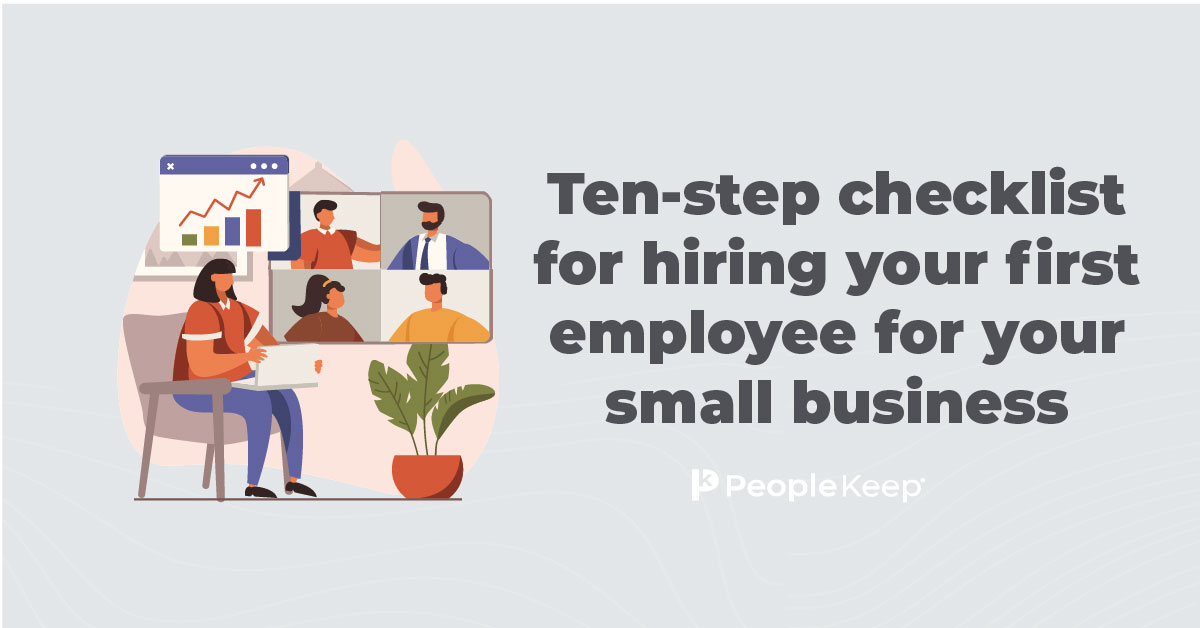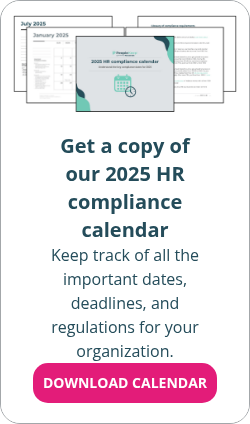Pre-employment screening: How to screen employees for a job
By Chase Charaba on December 12, 2023 at 12:15 PM
As a small business owner, human resources manager, or hiring manager, you're likely responsible for vetting job candidates for your open positions. It's crucial that you select the right person for the job. Selecting the wrong individual can be costly. After all, bad hires result in higher employee turnover.
Pre-employment screening can help you reduce the risk of hiring the wrong candidate. While it doesn't guarantee that a candidate will stay at your organization and fit into your culture, it does ensure candidates meet your job qualifications.
In this article, we'll explain how to screen employees for a job. We'll also examine the different types of pre-employment screening during the hiring process.
What should you look for during pre-employment screening?
The pre-employment screening process allows you to gather additional information about candidates to make more informed hiring decisions.
Screening generally identifies:
- Qualifications, such as proof of skills candidates need to be successful
- Personality traits
- How candidates will fit into your existing culture
- Educational experience
- Professional experience
- History of drug abuse or criminal convictions
By examining your potential employees' backgrounds, you can determine whether they’re a good fit for your organization. For example, a criminal background check can help you decide whether a prospective employee is trustworthy if their role will deal with sensitive information or finances.
What are the different types of screening?
There are many different types of screening processes available. Depending on your organization's size, industry, and state or local laws, some screening methods may be a better option for your organization.
Generally, screening occurs at three different stages of the hiring process:
- Pre-interview screening: Examples include looking at job applications and resumes, conducting phone or video interviews, and requiring personality tests
- Interview screening: This includes speaking with candidates to determine if they qualify for the position and fit your culture
- Post-interview screening: Includes performing criminal background checks, social media checks, reference checks, and other screening methods
We'll look at some of the most common screening methods in the sections below.
Criminal record checks
This type of background check can help you see if your top candidate has a criminal history or felony conviction. This usually involves searching a combination of records from various government sources.
Criminal record searches might include the following:
- FBI fingerprint data1
- Federal criminal records2
- State criminal records
- County criminal records
- National Criminal Record Search
- National Sex Offender Registry3
Before conducting pre-employment background checks on potential employees, you'll need to familiarize yourself with state laws to avoid legal issues. For example, some states have laws for a seven-year lookback period for criminal convictions. This means they don't report any criminal history before that time.
Seven-year lookback states for criminal convictions include:
- California
- Kansas
- Maryland
- Massachusetts
- Montana
- New Mexico
- New York
- New Hampshire
- Washington
There’s also a lookback period on non-convictions, such as dismissed cases. Under the federal Fair Credit Reporting Act 4(FCRA), only non-convictions from the previous seven years can appear on a background check report. However, some states have banned non-convictions from appearing on records entirely.
These states include:
- California
- Kentucky
- New Mexico
- New York
States may also prevent you from asking about criminal history on a job application. You can't conduct a background check in these states until you've made a conditional job offer.
Credit checks
A credit check provides insight into a potential hire's credit history. Employers often conduct credit checks for candidates applying for financial roles within a company or any position that involves handling money, such as accountants or retail roles. Under the FCRA, organizations must obtain written consent from applicants before accessing their credit history.
Previous employment verification
Many organizations verify an applicant's employment history. This is because job applicants write up their resumes and applications. Sometimes, applicants may embellish their resumes to look like the perfect candidate.
Employment verification includes making reference checks and contacting the employers listed. This generally involves asking if your candidate worked there and for how long. Sometimes, you can ask about a candidate's job title, specific duties, or why they left their previous employers, but many organizations don't provide this information.
Education verification
Just like with employment history, you can verify a job applicant's education experience to ensure they have the right qualifications. You can contact a university or college to verify attendance dates, the degree earned, and GPAs. However, schools must have permission from the former student to release any information.
Personality tests
You can have candidates take an aptitude or personality test before conducting a second interview or extending an offer. These tests provide valuable insights into a candidate's soft skills, personality, and how they'll work with others.
However, it's important to remember that these tests aren't always accurate or absolute. Applicants can select incorrect answers based on what they think you want, or they may be on the border between different types.
Drug testing
Some organizations conduct drug testing to ensure productivity and prevent drug-related workplace injuries. For example, many organizations with employees who operate machinery conduct regular drug testing.
Before conducting drug tests, you'll need to know your state's laws5 regarding testing.
Driving records
If your organization is hiring for positions where you expect employees to operate machinery or vehicles, it's a good idea to check candidates' motor vehicle records. This can reveal information about license suspensions, crashes, and violations.
Social media screening
You can also use social media platforms to get a more accurate pulse on potential employees. Employers in many states can use social media as part of their recruitment process and conduct social media background checks.
The advantages of using social media to screen candidates include learning more about their personality, background, affiliations, and values. For example, you might find that an individual belongs to clubs or groups that contradict your organization's vision and could damage your company's image or reputation.
When using social media to screen candidates, you must consider legal risks. Social media can reveal information about protected classes, such as age, ethnicity, religion, or sexual orientation. HR managers can minimize this risk by using social media screening as part of a background check after extending a conditional offer. HR or a third party should conduct social media checks to ensure the hiring manager receives only relevant information.
Sometimes, a candidate's account might be private. Some employers ask candidates and employees for social media usernames and passwords to gain access to their candidate's accounts.
However, some states have banned asking for social media access. These states include:
- Arkansas
- California
- Colorado
- Connecticut
- Delaware
- Illinois
- Louisiana
- Maine
- Maryland
- Michigan
- Montana
- Nebraska
- Nevada
- New Hampshire
- New Jersey
- New Mexico
- Oklahoma
- Oregon
- Rhode Island
- Tennessee
- Utah
- Virginia
- Washington
- West Virginia
- Wisconsin
Search engine screening
Another tool employers can use to screen applicants is to search for them on Google. This can show you additional information to help screen suitable candidates, such as public records, social media profiles, and personal websites.
Like social media screening, search engines can reveal information about protected classes, so you'll need to be careful to avoid discriminating against candidates.
How to attract qualified candidates
If you're finding that the candidates for your open positions aren't the right fit, you may need to reexamine your job requirements, job description, application process, and employee benefits.
To attract top talent, you need to offer a competitive employee benefits package that appeals to the candidates you want.
According to our 2022 Employee Benefits Survey Report, 82% of employees said the benefits package an employer offers is an important factor in whether or not applicants accept a job offer. If you aren't offering the right benefits, potential hires might not apply.
According to our Employee Benefits Survey Report, some of the top benefits employees want include:
- Health insurance
- Dental insurance
- Paid time off (PTO)
- Retirement benefits
- Flexible work schedule
- Paid family leave
- Mental health benefits
- Professional development
The most requested benefit is health insurance. However, many small employers find it challenging to offer traditional group health insurance due to rising premiums. Thankfully, there are other health benefits available.
One of the best ways to provide a health benefit to your employees is through a health reimbursement arrangement (HRA). You can reimburse your employees for their qualifying medical expenses and individual health insurance premiums with an HRA. You simply set a monthly allowance for reimbursement and only pay employees for the expenses they incur. Any unused funds stay with you at the end of the year.
You can also offer an employee stipend to expand your compensation package. With stipends, you can offer a custom monthly allowance for your chosen expenses.
For example, you could offer a wellness stipend to reimburse employees for their wellness expenses. This might include gym memberships, wellness mobile apps, or any other wellness expense you allow.
Conclusion
Pre-employment screening is an effective way to determine if a candidate meets your job requirements and company culture. Using some of the screening methods this article covers can help you avoid a bad hire and make more confident hiring decisions.
Once you've vetted your candidates and made an informed decision, you'll need to ensure you retain your talent. You'll need to offer personalized benefits if you want to retain your employees while improving their job satisfaction and performance.
If you're ready to offer affordable, personalized benefits to your employees, PeopleKeep can help. Our benefits administration software makes it easy to set up and manage HRAs in minutes each month.
This blog article was originally published on April 20, 2015. It was last updated on December 12, 2023.
- https://www.fbi.gov/how-we-can-help-you/need-an-fbi-service-or-more-information/freedom-of-informationprivacy-act/department-of-justice-fbi-privacy-impact-assessments/firs-iafis
- https://www.justice.gov/jmd/ls/state
- https://www.nsopw.gov/
- https://www.ftc.gov/legal-library/browse/statutes/fair-credit-reporting-act
- https://www.aclu.org/other/state-state-workplace-drug-testing-laws
Check out more resources
See these related articles

Ten-step checklist for hiring your first employee for your small business
If you’re new to the hiring process, finding your first employee can be daunting. Learn the ten steps to hiring your first employee with our checklist.

How to welcome a new employee
Welcoming a new employee is an important step in ensuring their success within your organization. Get tips on how to properly welcome a new team member.

What is the employee life cycle?
Understanding the employee life cycle is crucial for HR teams. Dive into this guide to gain insights on each stage and optimize your management strategies.



